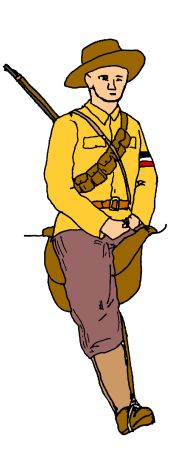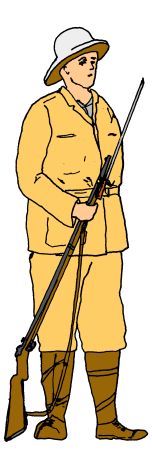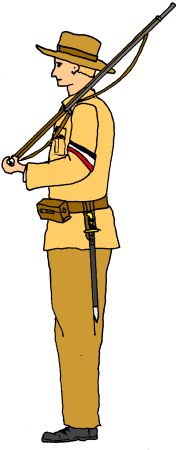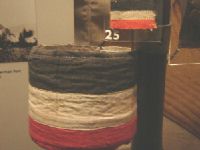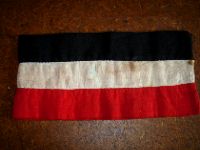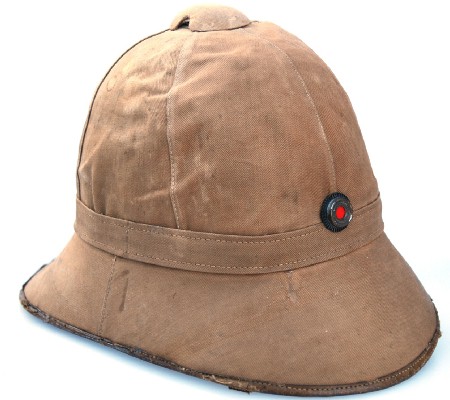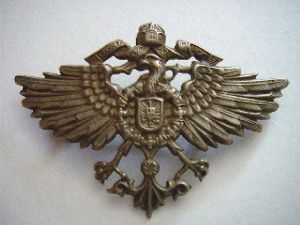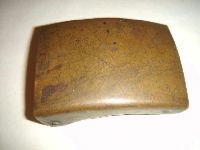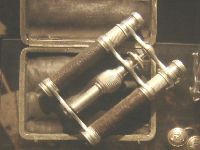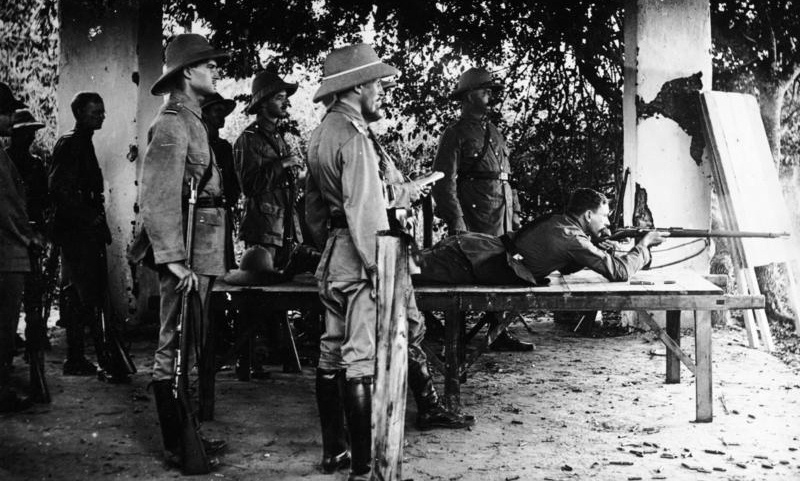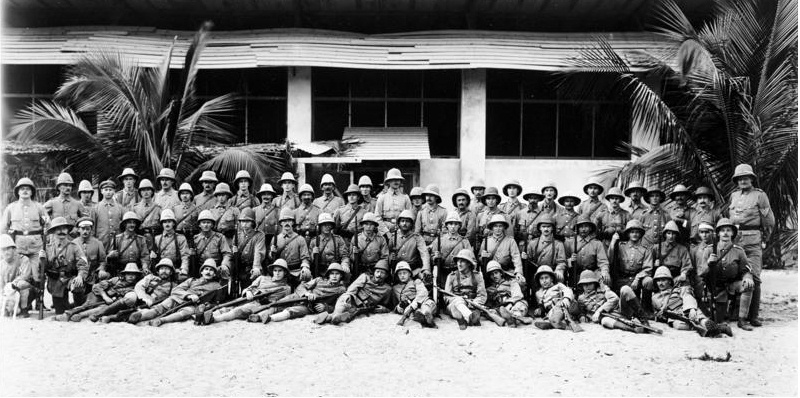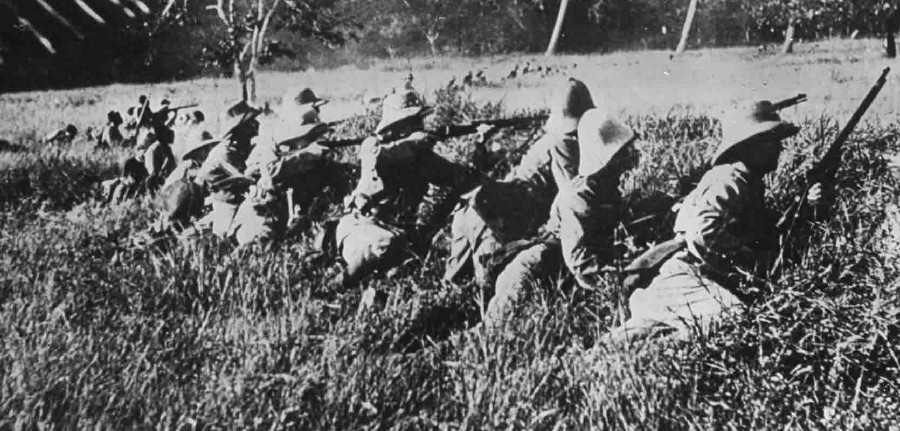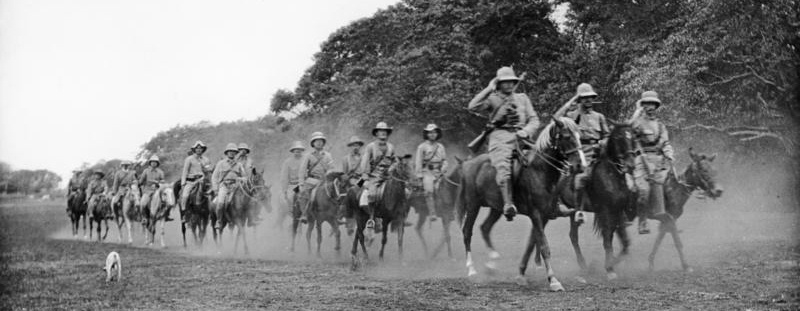Uniforms of the
Schützenkompagnien Unlike in South West Africa, there were no large stocks of spare Schutztruppe uniforms in East Africa. These reservists wore whatever uniforms and weapons they could provide themselves along with small stocks of issue uniforms or items improvised by the Schutztruppe such as old tropical helmets and miscellaneous tunics. As they had no standard uniform, many of the reservists were initially issued with (or improvised) armbands in the imperial colours to identify themselves in action. The armbands were later replaced by less conspicuous small strips of the imperial colours worn on the shoulder strap. Most of the reservists were initially issued with the Jägerbüchse 71 rifle as used by most Schutztruppe askaris at the time, although some appear to have carried their own personal firearms. Within a few months of the outbreak of war these troops were fully integrated into the Schutztruppe and bloodied at the Battle of Tanga. Over the following years and they were and mostly re-equipped with more regular uniforms and newer rifles, either Mauser G98's or from captured stocks.
The Illustrations Figure 1 is based on an early wartime photograph of one of the Schützenkompagnie Mounted Volunteer units which were formed among German residents and farmers mainly in the North of German East Africa to raid in to British East Africa. This figure, like his comrades in the original photograph, wears nothing to identify him as belonging to either side or even particularly as a combatant except for a black, white and red armband (see above). He wears civilian clothing entirely and is armed with a hunting rifle and carries a non-regulation bandolier giving an appearance very similar to the Boer irregulars during the Anglo-Boer War 1899-1902. Figure 2 is based on an early wartime photograph of a Schützenkompagnie Reservist. He wears a white tropical helmet, with khaki tunic and trousers and brown leather gaiters and boots. All these items seem to be non-issue and were probably owned by the reservist himself. He appears to wear no sign of belonging to either side, although it is possible that he wears an armband in the imperial colours on his left arm. Figure 3 is based on an early wartime photograph of a Schützenkompagnie Reservist taken at the funeral of the pilot Oberleutnant Erich Henneberger in November 1914 (see Aircraft in the Colonies Page). He wears a slouch hat, with khaki tunic and dark trousers. All these items seem to be non-issue and were probably owned by the reservist himself. On his left arm he wears an armband in imperial colours (see right) for identification. He carries a Jägerbüsche '71 rifle with an S71/84 bayonet and 1871 pattern ammunition pouches hung from a brown leather belt. Figure 4 is based on a wartime photograph of a Schützenkompagnie Reservist probably taken in late 1914, 1915 or 1916. He wears a khaki tropical helmet with a small imperial cockade on the front (see above). His khaki tunic seems to be of the type usually issued to Schutztruppe askaris (see German East African Askari Uniforms 1896-1914 Page). He wears khaki trousers and brown leather gaiters and boots. Most of these items seem to be supplied from miscellaneous Schutztruppe stocks. He wears small strips of cloth in the imperial colours on his shoulder straps (see above). Figure 5 is based on a wartime photograph of a Schützenkompagnie Reservist NCO probably taken in late 1914, 1915 or 1916. He wears a khaki tropical helmet with a khaki pugaree scarf around the hatband, a small imperial cockade and above it an imperial eagle badge. These eagle badges have been seen worn by all ranks of some Schützenkompagnien appear to be the same as those issued to the Schutztruppe askaris on their headdress (see below). His khaki tunic has a standing collar and a single left breast pocket and seems to be of a similar pattern to that used by the East Asian Expeditionary Corps and early Polizeitruppe Officers in some colonies. He wears small strips of cloth in the imperial colours on his shoulder straps (see above). Up to his breast pocket, he has a watch chain although it may be for a signalling whistle. His brown leather belt is buckled by a plain brass buckle as usually issued to askaris (see below) He wears khaki trousers and brown leather gaiters and boots. Most of these items seem to be supplied from miscellaneous Schutztruppe stocks. From the original photograph it appears that he wears no rank insignia. His NCO rank in the original photograph is only implied by the fact that he stands unarmed, with signalling whistle and binoculars at the end of a row of armed other ranks. The binoculars he carries look a little worse for wear and may be improvised, owned by the NCO himself or even opera glasses (see below).
|
